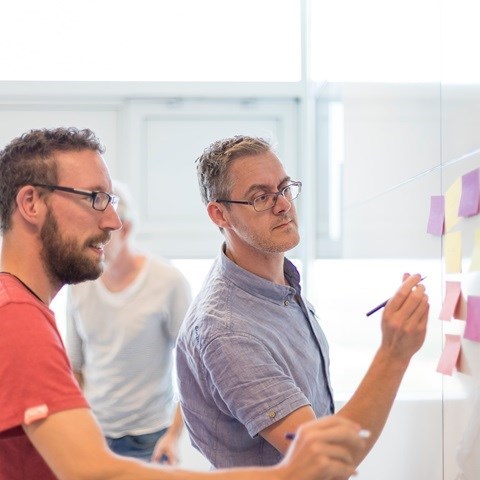Accelerating business value through continuous development

Customers are usually very excited about the product that’s delivered by a Scrum project and the close cooperation in a team. Due to the constant focus, a useful app or website has been built quickly and with a fixed budget. But what happens to the user stories that initially did not make it to the final product? And what if there are new insights after the product is launched that demand new features?
Scrum-pause-Scrum
Of course, you can always plan a new Scrum project to take your website, software or app to the next level. However, the disadvantage of this Scrum-pause-Scrum approach is that you lose a big part of the agility, the reason for choosing an Agile method like Scrum. If you come up with extra wishes and new ideas at the end of a Scrum project, you have to wait until the next project to develop them. Sometimes, you have to wait more than half a year before the start of a new project. Additionally, every time you start a project, the new team has to get to know each other. Everyone has their own methods, so it takes time to become a well-oiled machine.
Continuous development
When a product is still in development (we call this a ‘moving target’) and the final feature set is not fixed yet, a continuous development approach is the best approach. This way, Scrum projects follow up on each other immediately, with a new version of the software, app or website released at the end of every project. Another approach is to work in sprints and release a new version every two or three weeks. This way, you are not only able to use extra features earlier, the return on investment of your digital product will also increase.

Less project management
If you’re working with a fixed team on software, an app or website, all kinds of project management tasks are no longer needed. For example drafting a project proposal, quotation and planning. Or to find accommodation, setting up meetings to meet new team members, etcetera. These may seem like small tasks, but if you are able to drop them, it will add a lot of extra time which can be used for actual development.
Continuous development is not only a chance to continuously improve your product. You are also able to continuously improve your work processes. This way, continuous development fits our motto: Get Smarter Every Day.
Christian Haverkamp, Team Lead & Scrum Master
More user stories per sprint
Another big advantage is that people who work together for a longer period tend to collaborate better during projects, especially in teams where team members are from different organisations. It will take some time before everyone is on the same page and understands each other. Moreover, the energy of the group will stay when the team is dedicated on developing an app, website or software together. If you stop to start again later, people will need time to adjust and catch up again. That is, if you are able to get all the team members from previous projects together again.

Business value central
Continuous development asks a different way of thinking for the management team than the traditional way, where arrangements about the release (for instance the scope, planning and budget) are made in advance. With continuous development, you make budget available without having a clear picture of the exact future features. The latter is often a point of uncertainty for decision makers.
Clear goals
In contrast, continuous development certainly is not a carte blanche for the product owner and his team to experiment with. The product owner must make sure there is a clear product vision that is backed by all stakeholders. Next, it is up to the product owner to translate this vision into a clear roadmap with features and user stories. It should always be clear how the different features contribute to the business value of the product.

Measuring progress
If you know what the business value of new features or user stories should be, you are able to measure if they live up to their expectations. This is possible by using analytics, multivariate testing (A/B) or by qualitative research such as online surveys or user testing. The advantage of continuous development is that if you notice certain features in the software, app or website do not contribute or contribute less to the business value than anticipated, you can adjust the direction immediately; you do not have to wait six months for the next Scrum project to start, which is a lean and effective approach.
A well-filled backlog
Continuous development is only useful if a team can add sufficient business value to a product during the sprints. Thus, the product owner must provide a well-filled backlog. Which is why this way of working is especially suitable for apps, websites or software that support complex business processes or are meant for a market that changes quickly. These do not have to be completely new solutions. Iquality has a sophisticated onboarding process to tackle the further development of your software, apps and/or websites lean and iteratively.


